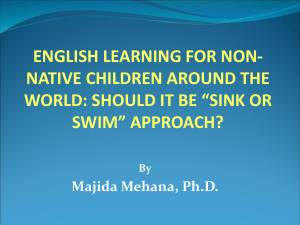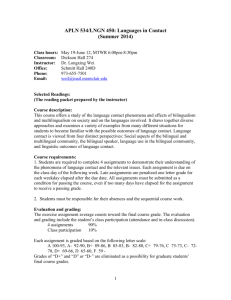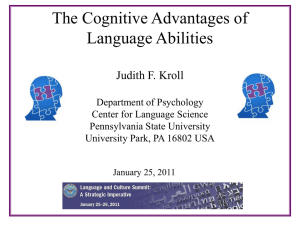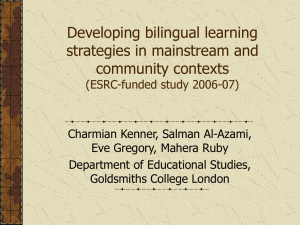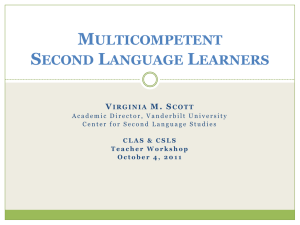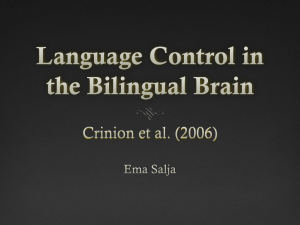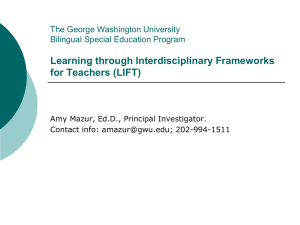Crossing Cultural Borderlands
advertisement
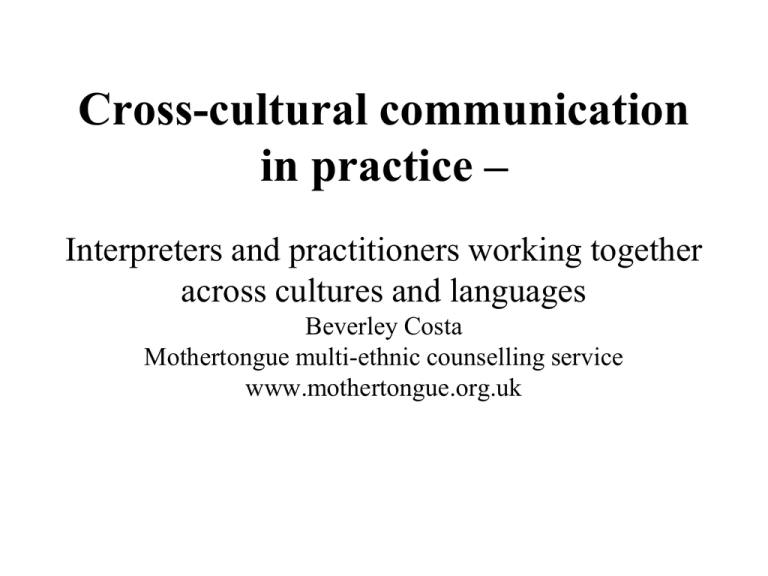
Cross-cultural communication in practice – Interpreters and practitioners working together across cultures and languages Beverley Costa Mothertongue multi-ethnic counselling service www.mothertongue.org.uk Outline Why are we interested in this? • Bilingualism and the effects it has on emotional development • Language switching as : Defence Expression Protection • Learning from bilingual and multilingual counsellors Understanding the untranslatable “Every language contains its own naïve picture of the world including its own ethnopsychology” ( Apresjan, 1974) • Abstract words for emotions, concepts, and values vary across languages • Translating them into the English language reflects the concepts and values of the Englishspeaking culture • Concepts exist in some cultures and not others • For example, how would you translate “date rape”, “ you are not in trouble”, you are having a hard time” etc. ? The communication – direct and indirect model (Edward T. Hall, 1966) Individual world view : Coping Strategies Assertiveness, expressing emotions, goal orientated, confrontational, Individual world view: Communication Style direct communication style – verbal communication mainly Collective world view - Coping Strategies Avoidance, forebearance,social support, Collective world view: Communication style indirect communication style – context important Hofstede’s (1983) Intercultural elements • Individualist cultures include the United States and much of Western Europe, where personal achievements are emphasised. Collectivist cultures, such as China, Korea, and Japan, emphasize the group such as the family and at work this manifests in a strong work group mentality. • A person's identity revolves around the "I" . Personal goals and achievement are strived for . It is acceptable to pursue individual goals at the expense of others . 'Individualism' is encouraged whether it be personality, clothes or music tastes . The right of the individual reign supreme; thus laws to protect choices and freedom of speech • In a country that scores low on the individualism scale the following traits are common: . "We" is more important that "I" . Conformity is expected and perceived positively. . Individual's desires and aspirations should be curbed if necessary for the good of the group. . The rights of the family (or for the common good) are more important. . Rules provide stability, order, obedience. • Marian and Kaushanskaya (2005: 1479) suggest from their research that: “...when speaking a language associated with a more individualistic culture, bilinguals produce more individualistic narratives, whereas when speaking a language associated with a more collectivist culture, bilinguals produce more collectivist narratives, regardless of language of encoding or main agent in the narrative.” IMPACT/ADAPTATION OF CBT? Clinical example • George and Vasso Vassilou (1973) refer to the cultural constructs that we may have as: “subjective culture”. They give an example of an American psychodramatist conducting a psychodrama workshop in Athens. The psychodramatist set up an example of a mother who was twice divorced and ready to marry again who was bringing her unhappy daughter for psychotherapy. No one in the group was willing to take the part of the mother. Initially interpreting this as resistance in the group, the psychodramatist was finally persuaded by the group that the idea of such a Greek mother was unthinkable as such a mother would be dishonouring the family with her loose morals. There was no possible warm up by the group members to the role of this mother as the psychodramatist had not developed enough cultural empathy with the world view of the group and had missed the meaning they were ascribing to the role. Berry’s (1998, 2001) model of acculturation Separation may occur when people place a high value on maintaining their own culture without any external influence and low value on the culture they have migrated to. Assimilation may occur when people place high value only or mainly on the new culture to which they have migrated. Marginalisation may occur when people feel alienated both from their heritage culture and the culture in which they are living. Integration occurs when people find a way to integrate, incorporate and live out their varying experiences of culture. Splitting that can occur in bi/multilingualism “When we change languages, both our worldview and our identities get transformed. We need to become new selves to speak a language that does not come from our core self, a language that does not reflect our innerconnectedness with the culture it represents.” A client’s view It is very hard to a person who leaves everything, his country, language, food, clothes, people, and family we know that if they haven’t got problem they would never leave them because these things can be the loved once ever in their life but unfortunately they have to, to save their life and live calmly • “As an immigrant…. familiarity with the official language, that immensely valuable and essential tool of communication, has been a determining factor in the process of acculturation.” • Imberti P. Exploring and understanding the Language Experience of the Non- EnglishSpeaking Immigrant. Families in Society: The Journal of Contemporary Social Services; 2007: 71 Native language and emotions • Learning a language early promotes heightened emotionality of native language compared to additional language because: – Family context of learning – First language learning co-evolves with emotional regulation systems – Native language has greater connections with subcortical brain structures which mediate arousal (including amygdala-mediated learning) The neurobiological perspective • The amygdala judge emotion expressed in voices very fast • They are the brain’s emotional sentinel • The prefrontal lobes( the decision-taking centres) control the amygdala and can reduce emotional intensity by allowing the individual to reappraise a situation and adapt their reaction(LeDoux,2002) • The autonomic nervous system responds to signs of threat by preparing the body to take action – hence sweating of hands etc. • Skin conductance experiments ( compare lie detectors) can measure the transient , time specific increase in the skin’s electrical conductivity so it can be linked to a specific stimulus e.g. the language in which a word is spoken – results show that specific languages ( L1 or LX) can be experienced as highly emotional Catherine Harris(2006 ) When is a First Language More Emotional? Bilingual Minds , Anna Pavlenko Publisher: Multilingual Matters Ltd • “bilingual self” with an internal life, which is comprised of “a delicate duet of voices emanating from two different symbolic worlds.” • Perez Foster, R (1996). The bilingual self: duet in two voices. Psychoanalytic Dialogues 3:69-121. • “doubleness” experienced by bilinguals : “that of a neither/nor identity, rather than a both/and identity, which had also been referenced as “ outsider-ness” in each of her contexts.” • “ adults …constructed their multi/bilingualism as advantageous, creative, even radical.” • Burck, C. (2004). Living in several languages: implications for therapy; Journal of Family Therapy; 26(p323) • “cultural borderlands” Rosaldo R. Culture and truth: The remaking of social analysis. Boston Beacon Press; 1989 defined as: • “the overlapping zones of difference and similarity within and between different cultures. Borderlands give rise to internal inconsistencies and conflicts, but also offer many potential points of human connectedness with others.” Falicov C.J. Training to Think Culturally: A multidimensional Comparative Framework in An example of the split – in values • • • • • “- Should you marry him? The question comes in English -Yes. Should you marry him? The question echoes in Polish. -No… Should you become a pianist? The question comes in English. • -No you mustn’t. You can’t. • -Should you become a pianist? The question echoes in Polish. • -Yes, you must. At all costs.” Hoffman (1989) Integrating Factors • Finding a point of balance and integration • Including integration of experiences of migration and tensions of straddling cultures. • Using more than one language in a session can reinforce this sense of accommodation of tensions between differences. • “In some cases when clients can’t find any similar words in English they may use phrases or words from their language which I may not be able to understand but allows them to express the emotion.” • Moving between languages can validate and incorporate original culture and the country in which one lives. DEFENCE Not all therapists regard the ability to switch languages in therapy as necessarily positive • Kraph, E. E. (1955) considered that the choice of the languages to work in (for polyglot clients) was not always therapeutically beneficial – the client might choose the language that caused the least amount of emotional arousal. Client (L1 Greek, L2 English) self report “I think when I talk about emotional topics I tend to code-switch to English a lot. I remember when I was seeing a psychologist in Greece for a while I kept code-switching from Greek to English. We never really talked about this ( …) To my mind it may have been some distancing strategy…. (JM Dewaele, 2010) Emotional Expression • “Sometimes the acquisition of a new language can provide a person with the “right expression” for a particular sentiment, and thus can be used as a coping mechanism to express emotionally loaded experiences. ……a second language served as a vehicle to become more self regulated by finding ways to verbalise feelings that were once censored or restricted by external forces” • Imberti P. Exploring and understanding the Language Experience of the Non- English- Speaking Immigrant. Families in Society: The Journal of Contemporary Social Services; 2007: 71 • Loss or gain? Jean Marc Dewaele’s research participants: Estela, Romanian L1, German L2, French L3, English L4, Italian L5 “Romanian is more appropriate for hurting and insulting because it carries more weight and I can distinguish more nuances” Maureen, English L1, Italian L2 “I prefer to express my anger in Italian because I do not hear the weight of my words so everything comes out quite easily. Which unfortunately means I probably hurt people more than I intend to!” Protective function of second /subsequent language • A language learned after the early childhood years can serve as a protective psychic defence, de Zulueta, F. (1984,1990). • It can help clients to talk about traumatic events. If, for example, trauma happened in one language an individual may be able to talk about it in one of their other languages with a lessening of the emotional intensity, which makes it bearable. Language in which trauma is recalled • The Tehrani, N. & Vaughan,S. (2009) article: Lost in translationusing bilingual differences to increase emotional mastery following bullying. Counselling and Psychotherapy Research. Vol.9. No.1, explores the use of language switching in a bilingual client in order to increase emotional mastery after a traumatic experience: • “…where an individual is equally fluent in two languages the most significant factor in increasing the quality and emotional content of the recall is the language and context in which the incident was encoded.” p.11 • strategic use of bilingual identity for « repair » • Separate processing areas keep the intensity of feelings in one language separate from the experience of retelling the events in the other language. • This is partly explained by reference to Dufour and Kroll’s (1995) identification of two separate language stores in the brain for first and other languages. · Code switching and using more than one language • Maltese colleague, Maud Muscat works with bilingual children therapeutically • Choice of language at any given time – or language switching – a useful diagnostic tool in understanding a child’s anxieties/coping strategies • “ At times it is just a word, which can make all the difference. At other times adolescents and children find it easier to express themselves in one of the languages and not the other… it can express deeper emotions, can indicate the type of social background, communication carried out at home/school etc.” Significance and Meaning beyond the words • Counsellors who were interviewed talked about the importance in therapy of being able to see meaning beyond the spoken words of the client when there is a language barrier. The spoken word is not taken for granted as the sole carrier of meaning. • “Once past this (initial) stage, we move to a deeper level where language just serves the purpose of getting the meaning” “I have found that mostly they (clients) can be very eloquent even when they don’t know the words.” “Initially…I was very focused on the meanings of the words. Now…I am learning to read and see between lines of words.” Some practical suggestions 1.Think about what language proficiency means to your client. These questions may be useful initial prompts in an assessment session with clients: • What have their experiences of learning a new language been like? • What does the proficiency in the language represent for them? • What do they think they might gain in achieving proficiency in the new language? • What might they lose in the process? • In which language is it easier to get angry /express affection /be professional? 2. 3. Think about the way in which you use English. Think about other languages. In some languages there is no pronoun for the word “I”. What impact might that have on psychological formulations? Consider issues of power in the communication. Does the therapist speaks the language used in therapy better or worse than the client? What about accent? Are the therapist and /or the client speaking in the language of an oppressive coloniser and if so, what are the implications for the therapeutic alliance? 4. Learn a language, or reflect on experiences of trying to learn a language and impact on e.g.: your sense of identity, your self esteem, your understanding of others. Professor Jean- Marc Dewaele quotes a language teacher’s comments on the lack of confidence we have in Britain about learning languages: “I think that people still view learning other languages with a sense of fear. There seems to be this mystique about learning languages and many people decide early on in their lives that they can’t do it.” Dewaele, J (2009). IMPLICATIONS • Increasingly, people are moving across borders in pursuit of, for example, work, safety and refuge. Many will have experienced trauma. • What is the potential impact on us all if we decide not to think about the borders crossed when people learn a new language? • What is the potential impact on multilingual clients if they are left unable to speak and to be heard and understood? Suggested reading • • • • • • • • • • • Bradford, D.T. & Munoz. A. (1993) Translation in Bilingual Therapy in Professional Psychology: Research and Practice. Vol24. No.1, 52-61 Bernardes,D.(et al.) (2010) Asylum Seekers’ Perspectives, International Journal of Migration, Health and Social Care. Vol 6. Issue 4 Costa, B. When three is not a crowd. Professional preparation for interpreters working with therapists, ITI Bulletin, January-February, 2011 Costa, B. Managing the demands of mental health interpreting: why training, supervision and support are not luxuries, ITI Bulletin, March 2011 Muriel, P. & Smith, H.C. (2009) Talking Therapy in The Linguist. Vol48 No.2.The Chartered Institute of Linguists Perez Foster, R. (1998) The Power of Language in the Clinical Process: Assessing and treating the bilingual person. New Jersey: Aronson The Medical Foundation for the Care of Victims of Torture (2005) Code of Practice and Ethics for Interpreters and Practitioners in Joint Work Tribe, R. & Raval, H. (2003) Working with Interpreters in Mental Health. London: BrunnerRoutledge Tribe, R. & Thompson, K. (2008) Working with Interpreters in Health Settings: Guidelines for Psychologists. Leicester: The British Psychological Society Tribe, R. & Thompson, K. (2009a) Opportunity for Development or Necessary Nuisance? The Case for Viewing Working with Interpreters as a Bonus in Therapeutic Work in International Journal of Migration, Health and Social Care. Vol5. Issue 2 Tribe, R. & Thompson, K. (2009) Exploring the Three-Way Relationship in Therapeutic Work with Interpreters in International Journal of Migration, Health and Social Care. Vol5. Issue 2 Some more suggestions for reading • • • • • • • • • • Imberti, P. (2007) Exploring and understanding the Language Experience of the Non- EnglishSpeaking Immigrant. Families in Society: The Journal of Contemporary Social Services; 2007: 71 Rosaldo, R. (1989) Culture and truth: The remaking of social analysis. Boston Beacon Press Falicov, C.J.(1995) Training to Think Culturally: A multidimensional Comparative Framework in Family Process New York Costa B.. Psychodrama across Cultures. British Psychodrama and Sociodrama Journal; 2002 Lyons, J.(1981) Language, Meaning and Context. Fontana PaperbacksSmith H.C. Bridging the gap: therapy through interpreters in Therapy Today July 2008 Vygotsky, L.S. (1978) Mind and Society. Cambridge, Mass Harvard University Press Costa B. A working model of a community based, culturally sensitive counselling service, in Psychotherapy and Culture by Zack Eleftheriadou, Karnac Books 2010 Burck, C. (2004). Living in several languages: implications for therapy. Journal of Family Therapy, 26, 314-339. Burck, C. (2005). Multilingual Living: Explorations of Language and Subjectivity. London: Palgrave Macmillan. Vertovec, S. (2007) Super-diversity and its implications. Ethnic and racial studies 30 (6) p:10241054 De Maesschalck, S. (2012) Linguistic and cultural diversity in the consulting room: A tango between physicians and their ethnic minority patients. Unpublished Doctoral Dissertation, Ghent University. Research on therapy across languages at this link: http://www.language-and-psychoanalysis.com/CostaDewaele%20%282012%29.pdf Other references from this paper not in the text • • • • • • • • • • • • • • • • • • • Schrauf, R.W. (2000). Bilingual autobiographical memory: Experimental studies and clinical cases. Culture & Psychology, 6(4), 387-417 Harris ,C. (2006 ) When is a First Language More Emotional? Bilingual Minds , Anna Pavlenko Publisher: Multilingual Matters Ltd Panayiotou, A. (2004). Switching codes, switching code: Bilinguals’ emotional responses in English and Greek. Journal of Multilingual and Multicultural Development, 25:2&3, 124-139 Kanavillil Rajagopalan Emotion and Language Politics: The BrazilianCase Journal of Multilingual and Multicultural Development Vol. 25, Iss. 2-3, 2004 Karamat Ali, R. (2004), Bilingualism and systemic psychotherapy: some formulations and explorations. Journal of Family Therapy, 26: 340–357. doi: 10.1111/j.1467-6427.2004.00288.x a) Amati-Mehler, J. Argentieri, S. & Canestri, J. (1993). The Babel of the Unconscious, Mother Tongue and Foreign Tradition. Madison: International Universities Press. Perez Foster, R. (1996). The bilingual self: duet in two voices. Psychoanalytic Dialogues, 3, 69-121. Bowker, P., & Richards, B. (2004). Speaking the Same Language? Psychodynamic Practice, 10, 4, 459-478. LeDoux , J.E. (2002) Synaptic Self: How our brains become who we are. New York: Viking. Apresjan, J. D. (1974) Regular polysemy. Linguistics 14 (2):5-32 Hoffman, E.(1989).Lost in translation: A life in a new language. New York: Penguin Books. Kraph, E. E. (1955) “The choice of language in polyglot psychoanalysis.” Psychoanalytic Quarterly 24:343-357 Dewaele, J. (2009). “Age effects on self-perceived communicative competence and language choice among adult multilinguals.” Eurosla (9) John Benjamins Publishing Company ,245-268 Dewaele, J.-M. (2010) Emotions in Multiple Languages. Basingstoke: Palgrave Macmillan. De Zulueta,F. ( 1984) "The implications of Bilingualism in the study and treatment of psychiatric disorders: A Review", Psychological Medicine 14:541- 57. De Zulueta,F. (1990) "Bilingualism and Family Therapy", Journal of Family Therapy 12: 255-65. Dufour,R & Kroll,J.F. (1995) “Matching words to concepts in two languages: A test concept mediation model og bilingual memory.” Memory and Cognition, 23 (2), 166-180. Costa, B. (2010) Mother tongue or non-native language? Learning from conversations with bilingual/multilingual therapists about working with clients who do not share their native language , Journal of Ethnicity and Inequalities in Health and Social Care , 3:1: 15-24 Costa, B. & Dewaele, J.M. (2012) Psychotherapy across Languages: beliefs, attitudes and practices of monolingual
